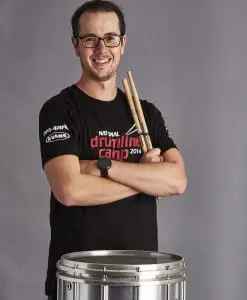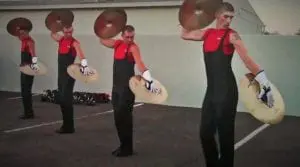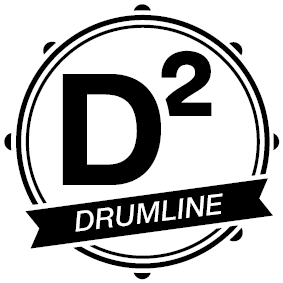About the Author:
 Campbell is the Founding Director of the D²Drumline, and the Drumline Association of Australia. He Lead Instructor of the National Drumline Camp and a specialist Drumline Teacher at Scotch College, Melbourne. As a performer, Campbell has toured the UK, China, New Zealand and Europe including a 2015 tour with the Blue Devils International and a 2008 Tour as Lead Snare of the Australian Hub in the Beijing Olympic Orchestra. He is a frequent clinician at both Secondary and Tertiary levels and has assisted a number of schools around Australia establish successful new Drumline programs. Campbell is a proud artist for Pearl Drums, Zildjian Cymbals, Evans Drumheads, Promark Stick.
Campbell is the Founding Director of the D²Drumline, and the Drumline Association of Australia. He Lead Instructor of the National Drumline Camp and a specialist Drumline Teacher at Scotch College, Melbourne. As a performer, Campbell has toured the UK, China, New Zealand and Europe including a 2015 tour with the Blue Devils International and a 2008 Tour as Lead Snare of the Australian Hub in the Beijing Olympic Orchestra. He is a frequent clinician at both Secondary and Tertiary levels and has assisted a number of schools around Australia establish successful new Drumline programs. Campbell is a proud artist for Pearl Drums, Zildjian Cymbals, Evans Drumheads, Promark Stick.
Part 1: Musician Placement, Rehearsal Technique, Warmups and Listening
To get the most of your musicians and allow your drumline to improve as quickly as possible you need to be aware of Musician Placement, Rehearsal Technique, Warm-ups and Listening. Addressing these four key areas will mean that your group’s time will be used as efficiently as possible and enhance the effectiveness of each rehearsal.
In this article we will explore some important considerations about how you utilise musicians in different areas of the drumline and how to start of your rehearsals on the right foot (so to speak!)
As always, if you have any questions or want some specific advice, please don’t hesitate to get in touch!
Musician Placement:

Each section of the drumline requires a unique approach to the instrument and a unique type of musician. Getting this right from the outset will not only help your line progress more quickly and effectively, but also play to the strengths of each musician in your group. This will allow to excel on their instrument and foster an enhanced sense of confidence in their abilities.
Lets have a look at the different requirement for each section:
- Cymbals: Cymbals are not a ‘lesser’ instrument, as many students often seem to think. They are the visual heart of the group and an incredibly important part of the drumline. Above all else, Cymbal players need to be creative and self-confident. They have to be willing to try new things, bring different and interesting ideas to the table for visuals, and sometimes look silly doing so. This willingness to takes risks requires a high level of self confidence and an outgoing, fun disposition. Musically, cymbals need to have good independence, and a solid understanding of syncopation and rhythm.
- Basses: Like cymbals, basses need to have very solid time and a good understanding of syncopation and rhythm. They need to be able to walk the fine line between playing independently (ie. not get thrown if another bass makes a mistake in a split), while still playing musically as part of their section. I like to think of each bass drum as a string on a guitar – they ALL have to work together to create their sound. When choosing which musician to place on which drum, you must of course keep physical size in mind, but also remember the following:
- Drum two (2nd from the top) is normally the most difficult – it will involve rudimentally challenging parts as well as complex timing and syncopation which often revolves around the ‘up-beat’.
- The bottom bass is the next most important part as most impacts land here. The bottom bass is also generally responsible for much of the timing and groove of a chart.
- Top bass will often be more the most rudimentally challenging, but syncopation and feel will be easier than drum two. Parts that are too hard rudimentally can easily be simplified so it is often a good idea to put your least experienced member on the top drum.
- Tenors: Tenors need to have very good fundamentals and should be able to play all their parts on one drum before worrying about moving around the drums. Tenor parts are often as rudimentally challenging as snare parts with the added complications of crossovers, sweeps and multiple drums. With this in mind, you tenors should be very well rounded musicians with good hands, solid time and good limb independence.
- Snares: Snares need to be the most rudimentally adept members of the drumline. While tenor parts will often be as rudimentally challenging as snares, each snare drummer needs to be able to focus not on himself, but on the lead snare. A snare drummer’s focus is more often on locking rolls, landing tight attacks, controlling their stick heights and showing off visuals. Technical imperatives such as grip, stick heights, dynamic control and locking rolls need to come naturally as a result of well developed hands so that snare drummers can focus on these other areas.
Rehearsal Technique:
The following points are essential for ensuring efficient, disciplined rehearsal. Every point below is equally important and should not be overlooked. These should form part of the expectations discussed in the previous article.
- Use a metronome wherever possible (it is very rarely not possible!). This will help internalise the time and ensure that all musicians are interpreting time the same. Use the smallest subdivision possible – a ‘beat’ or crotchet pulse is sometimes adequate, but often an 8th or even 16th note subdivision will lead to a more accurate interpretation of the time.
- Always mark time. Marking time ensures that your group knows where the beat is relative to the music they are playing. It also allows your Musical or Technical Director to visualise what each individual is feeling and correct any errors. If an individual cannot mark time to a chart, then they do not know where the beat sits despite what they may try to argue. Coordination, for example, is not an excuse. Marking time takes practice and needs to be worked on like anything else.
- Be strict with set and define every aspect of set as clearly as possible. As soon as set is called, every member of the line should go to the set position as soon as quickly as possible. Once at set, there should be no talking, no smiling, no scratching, no looking around – they should freeze and start to focus. If they are spoken to by their Director, no one in the group should respond while they are at set. If the Director expects a reply, they should tap out the line.
- Every member of the ensemble should have their music organised and in a folder. Disorganised music is a result of a disorganised approach to practice and will slow down a rehearsal while students try to find the right chart. Any wasted time can cause other members of the drumline to loose focus and loose their discipline.
- Do not overlook the importance of sectionals, particularly on more challenging or newer pieces. Ensemble development will take place mainly in warm-ups, while sectionals allow for individual improvement and greater cohesion within the section. A typical D² rehearsal will involve: 40min warm-ups, 1hr sectionals, 10min break, 30min full ensemble rehearsal.
- Break challenging sections down into small parts. There is nothing wrong with rehearsing one beat of music over and over if it is challenging. Do not be afraid to remove certain things when breaking the music down (ie. practice a section without a flam and focus on the rhythm) – this simplification will help with the overall understanding of the music before building it back up.
Warm-ups:
Warm-ups are the single most important aspect of any drumline rehearsal. They not only work on important fundamentals such as technique, uniformity of stick heights, locking rolls, and dynamic control, but also set the tone for the entire rehearsal. Efficient, well-run warm-ups will set the tone for the ensemble and will make your musicians focused and ready to absorb any new material or learning. A few key things to remember with your warm-ups are:
- Always use a metronome.
- Always mark time.
- Memorize all warm-ups. This is important to allow your musicians to focus on what the warm-ups are actually teaching them. Warm-ups are generally easy to memorize – there is no excuse not to.
- Every member of the drumline should be listening ‘in’ to the centre snare.
- Be aware of stick heights. There should be a pre-defined ‘tap’ height and a pre defined accent height for every dynamic level – these should be strictly observed and enforced. This applies to everyone, including for cymbals’ technique, positions and visuals. Using mirrors can assist with this.
- Never settle for less. If a warm-up starts poorly, cut the run, re-focus, and start again.
- Ensure your warm-ups reflect the music you are playing or are going to play. There is no point running through an odd time warm-up if you are never going to play odd-time. Similarly, you cannot expect you drumline to play flams well in a piece of music if you never practice them in warm-ups.
Make sure you keep your eyes peeled for future articles in this series, and please do not hesitate to request information about any specific topics or issues you may be facing within your line.


Responses